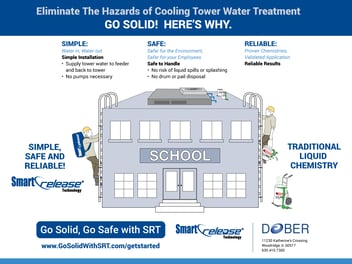Liquid vs Air Cooling for Data Centers
As data centers continue to evolve to meet the demands of artificial intelligence, high-performance computing, and cloud services, the challenge of managing heat generation has become increasingly critical.
Traditional air cooling methods, while reliable and widely adopted, are reaching their limits in efficiency and effectiveness.
Liquid cooling technologies have emerged as a compelling alternative, offering superior thermal management capabilities that address many of the shortcomings of conventional cooling approaches.
As the AI race heats up (figuratively), so, too, will the data centers powering the AI revolution ... although for data centers, it's a literal heating up, not figurative.
In its 2025 Data Center Marketplace report, Colliers cites Goldman Sachs, which forecast data center power demand to grow by at least 160% by 2030, "primarily driven by AI workloads."
So whether you're using AI to do a simple search or generate an image or construct a workflow that integrates with one or more other applications, your usage of AI generates heat down the line at the data center level.
That heat has to go somewhere. If it doesn't, you have a recipe for data center downtime and equipment failure.

How Does Liquid Cooling for data centers Work?
Liquid cooling in data centers is growing as the scale of data center operations surges.
The aforementioned Colliers reported touched on this:
Hyperscalers are no longer expanding incrementally; they are scaling to an entirely new level. The traditional development model has evolved into the construction of larger campuses designed to meet AI’s immense power needs. They require more power (kW) per rack, with innovations like liquid cooling, advanced power distribution systems, and AI-driven energy optimization to maintain efficiency at scale.
One market report forecasts the data center liquid cooling market to rise from $3.2 billion in 2023 to $16.4 billion by 2032, growing at a CAGR of 19%.
Why might data center operators be increasingly turning to liquids for their data center cooling needs?
Liquid cooling systems operate on the fundamental principle that liquids have significantly higher thermal conductivity and heat capacity than air.
The equation for thermal conduction, also known in mathematical terms as Fourier's law, is as follows:
q = −k∇T
In this formula, q represents heat flux density, while k is the thermal conductivity of the material and ∇T is the temperature gradient.
In layman's terms, when two materials come together, one with hot molecules and another with cold, a transfer of energy occurs in the direction of the hot material to the colder material. In other words, for liquid cooling, heat from the data center micro-processors, for example, is transferred to the heat transfer fluid.
Think of your morning coffee or tea. The vessel you drink these out of impacts how long it will remain hot. In this case, of course, you're trying to keep heat in so your drink remains hot. The type of material used for the cup, the thickness of the cup's walls and even its shape (i.e., surface area) impact how well it will retain heat.
Of course, in data centers, the goal is exactly the opposite: conducting heat away from expensive IT equipment and, eventually, into the external environment or waste heat reuse in other processes.
In data center systems, a coolant fluid circulates through a closed-loop network that directly contacts or comes into close proximity with heat-generating components. The process begins when the coolant absorbs heat from processors, memory modules, or other electronic components, causing its temperature to rise.
This heated coolant is then transported through pipes or channels to a heat exchanger or radiator, where the thermal energy is dissipated to the external environment. The cooled fluid then returns to complete the cycle.
The heat transfer mechanism in liquid cooling is far more efficient than air cooling because liquids can absorb and transport much more thermal energy per unit volume.
Water, for instance, has a heat capacity approximately four times greater than air, meaning it can absorb four times more heat energy for the same temperature increase. Additionally, the direct or near-direct contact between the coolant and heat sources eliminates many of the thermal resistance barriers present in air cooling systems, such as heat sinks and thermal interface materials.
What Types of Liquid Cooling techniques are available for data center applications?
The liquid cooling market offers several distinct technologies, each designed for specific applications and performance requirements.
Direct-to-Chip Cooling
In a direct-to-chip cooling approach, coolant flows through specialized cold plates mounted directly onto processors and other high-heat components.
This method provides the most efficient heat removal. However, infrastructure modifications and careful system design to prevent leaks are required.
Immersion Cooling
Immersion cooling takes a different approach by submerging entire servers or components in dielectric coolant fluid. Single-phase immersion cooling keeps the coolant in liquid form throughout the process, while two-phase immersion cooling allows the fluid to boil and condense, leveraging the latent heat of vaporization for enhanced cooling performance. These systems can achieve remarkable cooling efficiency while also providing protection against dust, vibration, and electromagnetic interference.
Hybrid Liquid Cooling
Hybrid liquid cooling systems combine liquid and air cooling elements, typically using liquid cooling for the most heat-intensive components while maintaining air cooling for less demanding parts. This approach offers a balance between performance improvement and implementation complexity.
Like those in the automotive market opting for a hybrid vehicle rather than jumping straight from a traditional gas-powered vehicle to a battery electric vehicle, the hybrid liquid cooling option is attractive for organizations seeking to upgrade their data center cooling regimen incrementally.
Rear Door Heat Exchangers
Rear door heat exchangers represent another category, replacing traditional server rack doors with liquid-cooled radiators. As hot air exits the servers, it passes through these heat exchangers where liquid coolant removes the thermal energy before the air enters the data center environment. This approach requires minimal changes to existing server hardware while providing significant cooling benefits.
what are the advantages of liquids for data center cooling Over Traditional Air Cooling?
Air cooling has been traditionally used for data center cooling, in many cases because of its low cost and easy attainability.
However, as seen in other industries — for example, thermal management for the battery electric and fuel cell vehicle applications — the new age of data center proliferation requires augmented cooling processes.
Below, we'll briefly review some ways in which liquid cooling can be advantageous compared to traditional air cooling methods:
Performance Efficiency
The efficiency gains from liquid cooling systems are substantial and multifaceted. Traditional air cooling systems often struggle with the physical limitations of air as a heat transfer medium, particularly in high-density computing environments where processors generate increasingly intense thermal loads.
Liquid cooling systems can remove heat more effectively, allowing processors to maintain optimal operating temperatures even under maximum load conditions.
This improved thermal management directly translates to better computational performance, as modern processors automatically reduce their clock speeds — measured in hertz, it's essentially the rate of which processors can execute instructions — when temperatures exceed safe thresholds.
Energy Efficiency
Energy efficiency represents another compelling advantage of liquid cooling technology.
Air cooling systems require powerful fans and extensive air handling units that consume significant electrical power while often creating inefficient airflow patterns within data centers. The pumps used in liquid cooling systems typically consume far less energy than the equivalent cooling capacity provided by air handling systems.
Depending on the specific implementation and environmental conditions, liquid cooling strategies can significantly reduce energy use. A team of Microsoft researchers conducted a lifecycle assessment of advanced cooling techniques, including liquid-based cold plate and immersion cooling, to quantify their sustainability benefits.1
The team concluded:
Our results demonstrate the importance of using LCA in early-stage design decisions to improve sustainability outcomes44 and show how cold-plate and immersion cooling have excellent potential for reducing environmental impacts such as GHG emissions (at least 15% reduction), energy consumption (at least 15% reduction) and water consumption (at least 31% reduction) per Vcore per year.
Space Utilization
Space utilization benefits are particularly relevant in modern data center design. Air cooling systems require substantial clearances around equipment for proper airflow, along with raised floors or overhead plenums for air distribution.
Liquid cooling systems eliminate many of these spatial requirements, allowing for higher equipment density and more efficient use of valuable data center real estate. This increased density capability becomes especially important as organizations seek to maximize computing power within existing facilities.
These days, no matter the industry, doing more with what you've got is vital.
Precision and Control
The precision and controllability of liquid cooling systems surpass traditional air cooling in several important ways. Liquid coolant can be directed exactly where it is needed most, providing targeted cooling for specific components rather than attempting to cool entire server enclosures. Temperature control is more precise and responsive, with liquid systems able to react quickly to changing thermal loads. This precision enables more aggressive processor configurations and higher sustained performance levels.
Noise Reduction
Noise reduction represents an often-overlooked benefit of liquid cooling implementation. Data centers using traditional air cooling require numerous high-speed fans operating continuously, creating substantial acoustic pollution that affects working conditions and may require additional soundproofing measures. Liquid cooling systems operate much more quietly, as the primary moving components are relatively slow-speed pumps rather than high-velocity fans.
Sustainability
From an environmental perspective, liquid cooling systems can contribute to improved sustainability metrics, and in many ways are more sustainable than traditional air-cooled systems.
The enhanced efficiency reduces overall energy consumption, directly lowering carbon footprints associated with data center operations, as noted in the aforementioned lifecycle assessment conducted by Hussam et al.
Additionally, many liquid cooling systems can utilize higher temperature coolants, enabling more efficient use of outside air for heat rejection or even waste heat recovery for building heating applications.
Liquid-cooled data center environments can also drastically reduce water usage in the cooling process, representing a critical sustainability benefit (not to mention a cost benefit).
in Conclusion ... data center cooling is evolving to meet the moment
While liquid cooling systems require higher initial capital investment and more sophisticated monitoring systems compared to traditional air cooling, the operational benefits often justify these costs in high-performance computing environments.
As processor power densities continue to increase and data centers face growing pressure to improve efficiency, liquid cooling technologies represent a critical evolution in thermal management strategy.
Organizations planning new data center facilities or major infrastructure upgrades should carefully evaluate liquid cooling options as part of their long-term operational strategy, particularly for applications involving artificial intelligence, machine learning, or other computationally intensive workloads that generate substantial heat loads.
Dober offers propylene glycol-based liquid cooling products for data center applications, COOLWAVE DC, that provides excellent heat transfer properties, in addition to vital corrosion and cavitation protection, and scale inhibition.
Learn more about COOLWAVE DC by clicking the button below.
Citations
1. Alissa, H., Nick, T., Raniwala, A. et al. Using life cycle assessment to drive innovation for sustainable cool clouds. Nature 641, 331–338 (2025). https://doi.org/10.1038/s41586-025-08832-3




